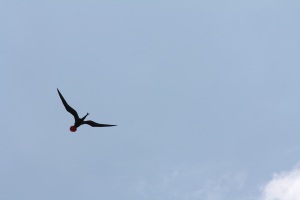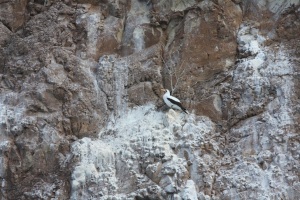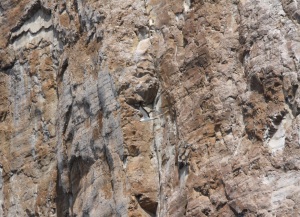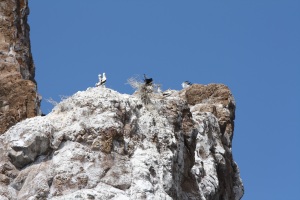Remember this from our arrival?
It’s known as Kicker Rock. The Spanish name is the Sleeping Lion; I have no idea why the English and Spanish names are unrelated. Tim and I did a day trip there. It’s an amazing place, with cliffs that not only plummet down to the water but continue straight down into the depths below. Exciting just to see the formation and the sea birds on and over it, but the real treat is snorkeling around it. Three ocean currents meet at the Galapagos – a warm one from Panama, that helped us get here quickly, the cold Humbolt current that comes up the coast of South America, and the deep ocean counter-current that flows opposite of the surface current that will push us toward the Marquesas soon. That confluence leads to great abundance of sea life, as nutrient-rich cold waters mix with the warm. In fact, swimming today the water mostly felt cold (we wore wet suits), but there were many pockets of much warmer water along the way.
Snorkeling next to a sheer wall, with the sunlight shining on the many colors of the wall, plus zillions of fish…quite an experience! Sorry I have neither underwater photos nor the poetic abilities to convey it. Tranquil sea turtles amble by below, while sea lions dart by inches away (sometimes scaring the dickens out of you, when they approach from behind and suddenly appear next to your face!), in the depths a few sharks (not people-threatening ones, though one of our group did spot a hammerhead), colorful fish, and if you dive down 10 feet a school of fish so thick it almost seems solid, all while frigate birds are soaring overhead. With minimal supervision (a guide who would point out what he saw, if you could hear him while snorkeling) we swam around the perimeter for an hour until most of us were exhausted as well as awed.
I do have photos of the rock and the birds on/around it…



And surprising in its familiarity, a great blue heron!

















I’m hoping that Galapagos is proving to be something of the place you had anticipated. My head would certainly be full of expectations from the books and pictures I’ve read and seen over the years.
I am curious to know how the influx of people are kept from doing harm to the wildlife on the island. By harm I mean not only physically, but also the stress the animals may feel with so many people in their habitat, with so many human smells and noise and disturbances, as well as being observed so much. I have been reading lately that all those things, including being watch, does often create anxiety among many animals. Not just there, but elsewhere, too. Finally, what is being done, if anything, to keep pollution and environmental damage under control?
These many be too many questions, but if you ever feel like discussing any of them at some point, I’d love to know your thoughts. That said, I realize I know you aren’t an expert on the island and what I have to assume are its on-going struggles with being rather popular.
LikeLike
Zeke’s, You write so well that I can feel your delight, awe, and warmth. Your descriptions allow us to travel with you a bit and experience your hardships, joys, learning experiences, and “sashimi” OMG! How crazy was that. Tortoises, sea lions, blue footed boobies, hammerheads, colorful fish, oh! My! What next!
You seem very at home! Be Well! Enjoy!
LikeLike